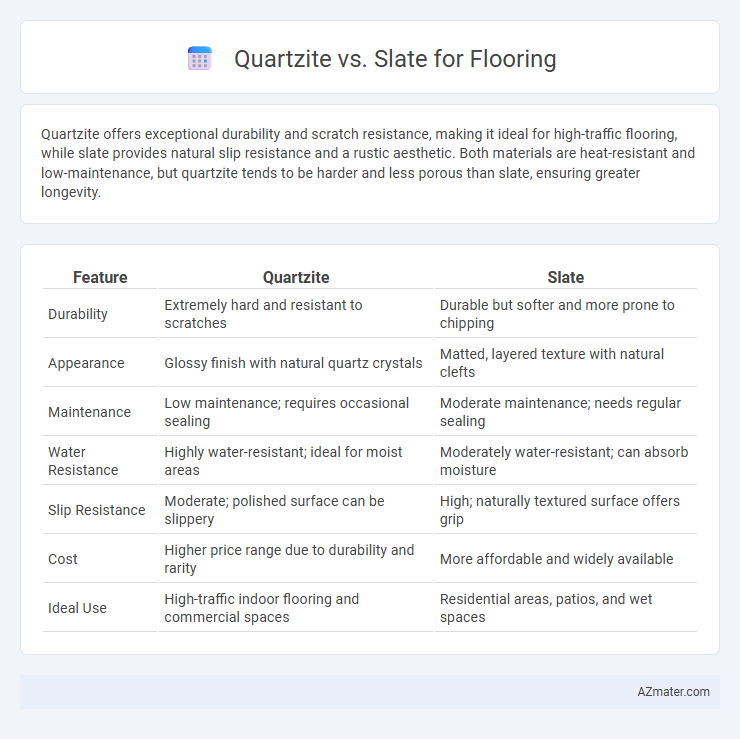Quartzite offers exceptional durability and scratch resistance, making it ideal for high-traffic flooring, while slate provides natural slip resistance and a rustic aesthetic. Both materials are heat-resistant and low-maintenance, but quartzite tends to be harder and less porous than slate, ensuring greater longevity.
Table of Comparison
| Feature | Quartzite | Slate |
|---|---|---|
| Durability | Extremely hard and resistant to scratches | Durable but softer and more prone to chipping |
| Appearance | Glossy finish with natural quartz crystals | Matted, layered texture with natural clefts |
| Maintenance | Low maintenance; requires occasional sealing | Moderate maintenance; needs regular sealing |
| Water Resistance | Highly water-resistant; ideal for moist areas | Moderately water-resistant; can absorb moisture |
| Slip Resistance | Moderate; polished surface can be slippery | High; naturally textured surface offers grip |
| Cost | Higher price range due to durability and rarity | More affordable and widely available |
| Ideal Use | High-traffic indoor flooring and commercial spaces | Residential areas, patios, and wet spaces |
Introduction to Quartzite and Slate Flooring
Quartzite flooring, forged from metamorphosed sandstone, offers exceptional hardness and durability with a natural quartz grain that enhances scratch resistance. Slate flooring consists of fine-grained metamorphic rock, prized for its layered texture, slip resistance, and ability to withstand moisture, making it ideal for bathrooms and kitchens. Both materials provide distinct aesthetic appeals and functional benefits, influencing choices based on durability, maintenance, and design preferences.
Key Differences Between Quartzite and Slate
Quartzite flooring is known for its unparalleled hardness and durability, boasting a Mohs hardness rating of 7, while slate is softer, with a rating of around 4 to 5, making quartzite more resistant to scratches and wear. The texture and appearance differ significantly; quartzite features a glassy, crystalline sheen with vibrant color variations, whereas slate offers a more matte finish with natural cleft surfaces and subtle earth tones. In terms of maintenance, quartzite requires sealing but is less prone to staining and moisture damage compared to slate, which is more porous and needs frequent sealing to prevent water absorption and potential damage.
Durability Comparison: Quartzite vs Slate
Quartzite offers superior durability compared to slate due to its natural resistance to scratching, chipping, and heat, making it ideal for high-traffic flooring areas. Slate, while also durable, tends to be softer and more prone to scratching and splitting under heavy use, requiring more maintenance. Both stones provide excellent longevity, but quartzite's hardness and density make it the preferred choice for long-lasting, resilient flooring solutions.
Appearance and Aesthetic Appeal
Quartzite offers a natural, glassy sheen with varying hues of white, gray, and pink that create a bright, reflective surface ideal for modern interior designs. Slate presents a more muted, matte finish with deep, earthy tones like green, black, and purple, providing a rustic, textured appearance suited for traditional and cozy settings. Both materials enhance flooring aesthetics, but quartzite's crystalline sparkle contrasts with slate's subtle, rugged character, allowing tailored visual impact based on design preferences.
Water Resistance and Maintenance
Quartzite offers superior water resistance compared to slate, making it a more durable choice for flooring in moisture-prone areas like bathrooms and kitchens. Slate, while naturally water-resistant, requires regular sealing to prevent water infiltration and potential staining. Maintenance for quartzite is generally lower due to its hardness and resistance to etching, whereas slate demands more frequent cleaning and resealing to maintain its appearance and functionality.
Installation Process and Challenges
Quartzite flooring requires precise cutting and professional handling due to its hardness and density, making installation more labor-intensive and time-consuming compared to slate. Slate offers easier workability with simpler cutting and shaping, reducing installation complexity and costs, but demands thorough subfloor preparation to prevent cracking. Both natural stones necessitate skilled installers to manage inherent variability and ensure long-term durability, with quartzite installations posing higher risks of equipment wear and slate installations requiring meticulous alignment for aesthetic consistency.
Cost Considerations: Quartzite vs Slate
Quartzite flooring typically costs between $6 to $12 per square foot, offering a durable and scratch-resistant surface ideal for high-traffic areas. Slate flooring ranges from $4 to $10 per square foot, providing a natural, textured finish with moderate maintenance requirements. While quartzite tends to be more expensive upfront, its superior hardness can reduce long-term repair and replacement costs compared to slate.
Environmental Impact and Sustainability
Quartzite flooring offers superior durability and natural resistance to weathering, making it a sustainable choice with minimal maintenance and longer lifespan compared to slate. Slate extraction tends to require more energy-intensive quarrying processes, which can lead to higher carbon emissions and environmental disruption. Both materials are natural stones with recyclable properties, but quartzite's hardness contributes to less frequent replacement, reducing long-term environmental impact.
Best Applications for Each Stone
Quartzite flooring excels in high-traffic areas like kitchens and hallways due to its exceptional hardness and resistance to scratches and stains. Slate is ideal for bathrooms and outdoor patios as its natural cleft surface provides excellent slip resistance and retains heat well, enhancing comfort. Both stones offer durability, but quartzite suits modern, high-use spaces while slate brings rustic charm to wet or uneven environments.
Choosing the Right Stone for Your Flooring Needs
Quartzite offers exceptional hardness and durability, making it ideal for high-traffic flooring areas, while slate provides a textured, slip-resistant surface suitable for wet or outdoor spaces. Quartzite's bright, crystalline appearance enhances modern interiors, whereas slate's natural cleft finish lends a rustic, earthy charm. Choosing between quartzite and slate depends on balancing aesthetics, durability, maintenance requirements, and the specific environmental conditions of your flooring project.

Infographic: Quartzite vs Slate for Flooring
 azmater.com
azmater.com